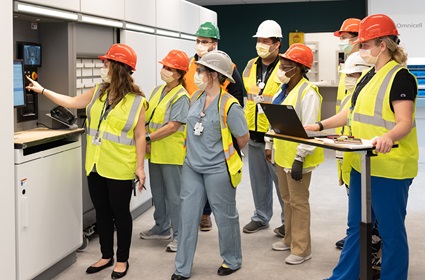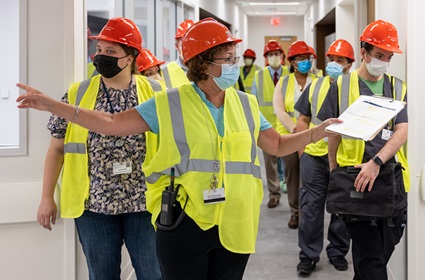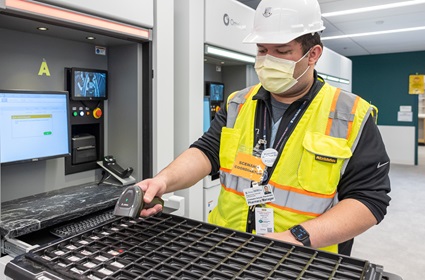Inside the Massive Staff Training to Prepare the Pavilion’s Workforce
 After more than four years of construction, the Pavilion, Penn Medicine’s state-of-the art new 1.5-million-square-foot inpatient facility at the Hospital of the University of Pennsylvania (HUP) will welcome its first patients in mere weeks.
After more than four years of construction, the Pavilion, Penn Medicine’s state-of-the art new 1.5-million-square-foot inpatient facility at the Hospital of the University of Pennsylvania (HUP) will welcome its first patients in mere weeks.
As the building was taking shape as a hospital designed for the future, multidisciplinary teams were looking ahead to what staff would need to succeed there. Among the essential strategies to prepare for its opening were a massive training and orientation initiative for staff — bigger than any in HUP’s history — and multidisciplinary dress rehearsals to test this training.
10,000 Employees in 12 Weeks
When the Pavilion opens, every employee who will work there in some capacity on day 1 — approximately 10,000 people — will have undergone a thorough and mandatory training in this new facility. “This is a state requirement,” stressed Denise Mariotti, HUP’s chief HR officer. “Our complex and comprehensive training plan is a requirement for licensure and demonstrates to state surveyors that our teams are thoroughly prepared to safely provide patient care and support in an entirely new facility.”
The training team not only created a general BOLS (Building Orientation and Life Safety) training for everyone but also helped every department and discipline create its own specific, customized training plans, 26 in all. “Our main focus has been to make sure staff are prepared to provide safe care from day 1,” said Beth Smith, MSN, NPD-BC, director of Nursing Professional Development, who, with Gretchen Kolb, MS, director of Learning Innovation at the Penn Medicine Academy, and Caitlyn Manning, MHA, education project manager, has overseen both training components.
 One of the team’s big challenges was orienting staff — the majority of whom had never stepped foot inside the new facility during its construction — to a new environment that is bigger and has so many different features than their current HUP departments.… and to do it quickly and efficiently. That meant developing messages and scripts (along with wayfinding maps) that would help employees feel familiar with the space every step of the way, from entering the building to using designated staff and patient transport elevations, and even learning to make sure they head the right direction on their floor!
One of the team’s big challenges was orienting staff — the majority of whom had never stepped foot inside the new facility during its construction — to a new environment that is bigger and has so many different features than their current HUP departments.… and to do it quickly and efficiently. That meant developing messages and scripts (along with wayfinding maps) that would help employees feel familiar with the space every step of the way, from entering the building to using designated staff and patient transport elevations, and even learning to make sure they head the right direction on their floor!
To reach everyone within their established 12-week BOLS training “window” (July through September), 250 training ambassadors were identified from all transitioning departments who would facilitate the training of their respective colleagues. Consistency was especially critical during these orientations, Smith said. “Everyone learned the same thing in the BOLS training no matter who was leading the group.”
In addition to navigation, training introduced new technology, such as IRIS, the Pavilion’s smart patient room system. IRIS is a “smart” monitor system which uses integrated technology to help personalize room controls, entertainment and education selections, and even the hallway-facing windows in patient rooms that can, with the press of a button, turn opaque for privacy without curtains.
All training took place in small groups of up to 15 people. At its peak, several hundred employees were being trained in the Pavilion during a single day, with start times staggered to limit the number of people in the facility at one time. The training team created a complex schedule based on the needs of each service line or department, and also coordinated with vendors to make sure they all knew the details of where they needed to go and when to educate staff on new equipment. Adding to the complex logistics, for most of the training, the Pavilion remained a construction site, so the personal protective equipment (PPE) required was not just a standard medical mask, but also a hard hat and vest!
By the end of September, the team had exceeded all of its goals for this extensive training initiative, but the work didn't end there. Teams are able to return to the building during the month of October to do things like test equipment, finalize a workflow, or secure extra time for wayfinding and orientation. “We have created a robust process to accommodate those requests in order to ensure our staff feel prepared and confident in their new space prior to the patient move,” Mariotti said.
Practice Makes Perfect!
Simulations have been a hallmark of the Pavilion project from the beginning. Indeed, a life-size mockup of half a patient floor created during the design stage allowed hundreds of employees — both clinical and nonclinical — the opportunity to physically see and test exactly what would work … and what wouldn’t. Their feedback was so impactful that the entire shape of the Pavilion was recast.
Now simulations are again playing an essential role. Three dress rehearsals (the last one is October 14) are a key step to ensure employees moving to or traveling into the Pavilion hit the ground running. At each rehearsal, each of the clinical teams and support staff practice three scripted “day in the life of” scenarios commonly performed and specific to their needs — some with added complexity. “Our teams know how to deliver great care and the dress rehearsal is the opportunity to practice their routine on a new stage,” said Alyson Cole, MPM, HUP’s associate executive director who is the leader overseeing the transition to the Pavilion. “The dual goal is to build staffing confidence working in the Pavilion’s new environment and to identify any final issues and correct those before opening.”
The first dress rehearsal, held in August, was the first time multidisciplinary clinical teams were together in the new environment. “Every staff role was present in the Pavilion to gain insight from their own department’s perspective,” Cole said.
The scenarios created for these simulations test every step in caring for patients. “We want to make sure employees understand what is new and different in their world,” she said, for example, using designated patient transport elevators and paths of travel.
 All of the dress rehearsal scripts, which were 18 months in the making, evolved from a standard template, originally mapped out as pathways on printed-out floor plans. Some were practices common to all staff (e.g., clock in and put away personal items when coming to work) while others were tailored to the specific department or unit with their leaders’ input. These department-customized scenarios were continually refined and then further reviewed by other departments that interact with them, such as Radiology, Laboratory Medicine, Pharmacy, and Environmental Services. “All the steps were validated,” Mariotti said.
All of the dress rehearsal scripts, which were 18 months in the making, evolved from a standard template, originally mapped out as pathways on printed-out floor plans. Some were practices common to all staff (e.g., clock in and put away personal items when coming to work) while others were tailored to the specific department or unit with their leaders’ input. These department-customized scenarios were continually refined and then further reviewed by other departments that interact with them, such as Radiology, Laboratory Medicine, Pharmacy, and Environmental Services. “All the steps were validated,” Mariotti said.
The dress rehearsals also test facility readiness, for example, is there a plug that didn’t work, a shade that didn’t lower, or a monitor that didn’t turn on? Each issue uncovered during dress rehearsals is documented, assigned a priority, and addressed.
August’s dress rehearsal was run prior to all equipment being in place, but that didn’t affect the impact of being in the facility, said Kristen Maloney, MSN, clinical director of Oncology nursing, who oversees 300-plus nursing staff. “It was time well spent together to work through questions, concerns, fears and anxieties. We came out with a lot more knowledge than when we walked in,” she said. “It zeroed in on many specifics of cancer care, such as infection control and new technology.”
Perhaps surprisingly, though, the feature that especially excited her team was the patient server, a two-way storage cabinet for supplies, medications and PPE, accessible from the hallway and patient room. “It’s eye opening to think about it being right there as they’re walking in or out of the patient room.”
Each of the next two dress rehearsals were designed to bring staff closer to a true “day in the life” experience, with more equipment in place and even the use of volunteer “mock” patients. “The dress rehearsals have made the move a reality for my team,” Maloney said. “It’s really happening!”
Family Connections in the Pavilion
 For a handful of the staff who toured and trained in the Pavilion over the last two months, there has been an extra personal connection. Some have been eager to get into the space knowing that they had family members who were part of the Pavilion’s construction team, and wanting to see their handiwork. When Rachel Mea, clinical practice lead RN on Dulles 6, a medical oncology unit, visited her future office on the 12th floor of the Pavilion, she saw more than new furnishings. On her desk was a note from her husband, Ryan: “Congratulations. Good luck in your new office!” Ryan is a member of Steamfitters Local Union 420 who had worked on the building in 2019 and then again this past summer.
For a handful of the staff who toured and trained in the Pavilion over the last two months, there has been an extra personal connection. Some have been eager to get into the space knowing that they had family members who were part of the Pavilion’s construction team, and wanting to see their handiwork. When Rachel Mea, clinical practice lead RN on Dulles 6, a medical oncology unit, visited her future office on the 12th floor of the Pavilion, she saw more than new furnishings. On her desk was a note from her husband, Ryan: “Congratulations. Good luck in your new office!” Ryan is a member of Steamfitters Local Union 420 who had worked on the building in 2019 and then again this past summer.
Mea has kept the note. Along with their names, written side by side on the last beam added to the Pavilion, it serves as a reminder of their mutual connection to this new chapter at Penn Medicine.